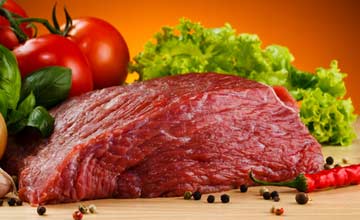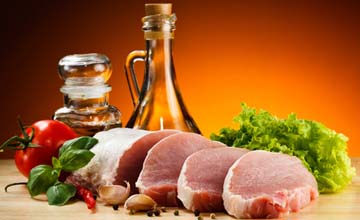What Grading Tells You About Meat
The grading service provided by the United States Department of Agriculture (USDA) is not, as you might expect, a regulatory action, but a voluntary process paid for by the members of the meat industry to promote quality and communicate levels of quality to consumers.

Grading has become an invaluable marketing tool that American consumers have learned to trust. Grades vary with the species and cover beef, veal, lamb and mutton, barrows, gilts, sows and poultry. Barrows are young, castrated hogs and gilts are young female hogs. Adult male hogs are not graded.
USDA Prime
The highest grade of beef is USDA Prime. It is characterized by generous fat marbling. Prime roasts and steaks are excellent choices for grilling, broiling, or roasting as they will retain moisture and flavor while cooking.
USDA Choice
The next grade down is choice. Although it has less marbling then prime, it still has enough fat content to add flavor and to stand up to dry heat cooking methods. You will need to exercise care to prevent overcooking and drying out the meat.
USDA Select
Select meats have less fat than the higher grades, but is probably still tender. The flavor and level of juiciness will also be less, making marinades, slow cooking, and other wet cooking methods more appropriate than dry heat.
Carmelo's Italian Ristorante
Authentic Italian Restaurant
321 W. Retta EsplanadePunta Gorda, FL 33950
Join us for 16oz Bone-in Ribeyes, 8oz Filet Mignons, Spaghetti Con Polpette, and more!
Standard Grade
The next grade is standard which has no marbling. The flavor and tenderness is lacking and it will likely be sold as a store brand with no grade indicated. Moist preparation is a must.
Commercial Grade
Commercial grade actually has some marbling, but the animal is more mature and the meat will likely be tough without treatment. It, too, will likely be sold as a store brand without grading indicated.
Utility, Cutter & Canner
Finally there is utility, cutter, or canner grade that has no marbling and comes from a more mature animal. It is generally sold only ground or in processed meat products.
Veal
Veal is categorized into five grades, since there will be no mature animals. As with beef, marbling levels dictate whether the cut is Prime, choice, good, standard, or utility. You will notice a lighter color in veal than beef, and the bones are smaller and softer. The most tender cuts are best for dry cooking methods, while those with less marbling are better served by slow cooking, sauces and marinades and other methods of retaining moisture.
Lamb
Lamb is only graded in three categories: prime, choice and good. As with veal, the fattier cuts such as roast and chops can be cooked effectively in the oven or on a grill, but those with less marbling should be cooked slowly with moist heat methods to ensure tenderness.
Barrows and Gilts
Barrows and gilts are only grades as 1,2,3,4 and utility, while sows are graded 1,2,3, medium and cull. Pork sold in stores is rarely graded because the meat is generally more uniform and tender than other meats. When buying pork, you should look for firm texture with good marbling and a grayish pink color.
Poultry
Generally poultry in stores will only be Grade A, free from bruising and broken bones. Grades B and C are generally only used in processed products.
By itself or as a great addition to your meat dish, this tomato basil salad is incredible!

- Meat Grades.com
- Copyright © 2012 - 2025
- All Rights Reserved
- Privacy Policy
